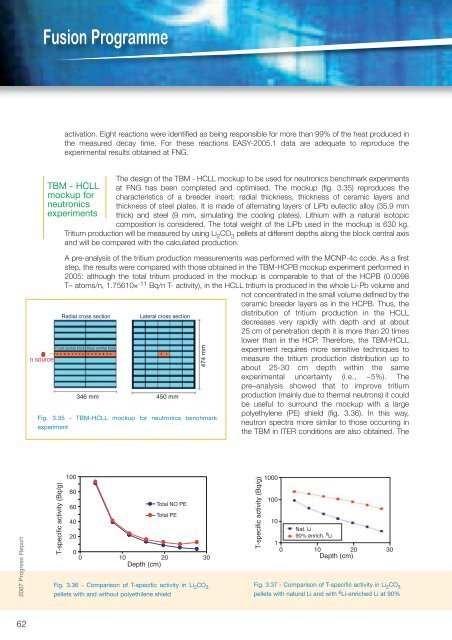Fusion Programme - ENEA - Fusione
Fusion Programme - ENEA - Fusione
Fusion Programme - ENEA - Fusione
- No tags were found...
You also want an ePaper? Increase the reach of your titles
YUMPU automatically turns print PDFs into web optimized ePapers that Google loves.
<strong>Fusion</strong> <strong>Programme</strong>activation. Eight reactions were identified as being responsible for more than 99% of the heat produced inthe measured decay time. For these reactions EASY-2005.1 data are adequate to reproduce theexperimental results obtained at FNG.The design of the TBM - HCLL mockup to be used for neutronics benchmark experimentsTBM - HCLL at FNG has been completed and optimised. The mockup (fig. 3.35) reproduces themockup for characteristics of a breeder insert: radial thickness, thickness of ceramic layers andneutronics thickness of steel plates. It is made of alternating layers of LiPb eutectic alloy (35.9 mmexperiments thick) and steel (9 mm, simulating the cooling plates). Lithium with a natural isotopiccomposition is considered. The total weight of the LiPb used in the mockup is 630 kg.Tritium production will be measured by using Li 2 CO 3 pellets at different depths along the block central axisand will be compared with the calculated production.A pre-analysis of the tritium production measurements was performed with the MCNP-4c code. As a firststep, the results were compared with those obtained in the TBM-HCPB mockup experiment performed in2005: although the total tritium produced in the mockup is comparable to that of the HCPB (0.0098T– atoms/n, 1.75610× -11 Bq/n T- activity), in the HCLL tritium is produced in the whole Li-Pb volume andnot concentrated in the small volume defined by theceramic breeder layers as in the HCPB. Thus, theRadial cross sectionFront central brick Rear central brickLateral cross sectiondistribution of tritium production in the HCLLdecreases very rapidly with depth and at about25 cm of penetration depth it is more than 20 timeslower than in the HCP. Therefore, the TBM-HCLLexperiment requires more sensitive techniques ton sourcemeasure the tritium production distribution up toabout 25-30 cm depth within the sameexperimental uncertainty (i.e., ~5%). The346 mm 450 mmpre–analysis showed that to improve tritiumproduction (mainly due to thermal neutrons) it couldbe useful to surround the mockup with a largepolyethylene (PE) shield (fig. 3.36). In this way,Fig. 3.35 - TBM-HCLL mockup for neutronics benchmarkneutron spectra more similar to those occurring inexperimentthe TBM in ITER conditions are also obtained. The474 mm2007 Progress ReportT-specific activity (Bq/g)10080604020Total NO PETotal PE00 10 20 30Depth (cm)Fig. 3.36 - Comparison of T-specific activity in Li 2 CO 3pellets with and without polyethilene shieldT-specific activity (Bq/g)100010010Nat. Li90% enrich. 6 Li10 10 20 30Depth (cm)Fig. 3.37 - Comparison of T-specific activity in Li 2 CO 3pellets with natural Li and with 6 Li-enriched Li at 90%62













